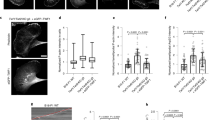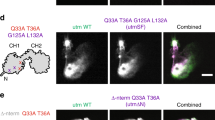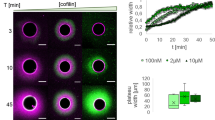Abstract
The ability of actin filaments to function in cell morphogenesis and motility is coupled to their capacity for rapid assembly and disassembly. Because disassembly in vitro is much slower than in vivo, cellular factors that stimulate disassembly have long been assumed to exist. Although numerous proteins can affect actin dynamics in vitro, demonstration of in vivo relevance of these effects has not been achieved. We have used genetics and an actin-inhibitor in yeast to demonstrate that rapid cycles of actin assembly and disassembly depend on the small actin-binding protein cofilin, and that cofilin stimulates filament disassembly. These results may explain why cofilin is ubiquitous in eukaryotes and is essential for viability in every organism in which its function has been tested genetically. Magnitudes of disassembly defects in cofilin mutants in vivo were found to be correlated closely with the magnitudes of disassembly defects observed in vitro, supporting our conclusions. Furthermore, these cofilin mutants provided an opportunity to distinguish in living cells those actin functions that depend specifically on filament turnover (endocytosis) from those that do not (cortical actin patch motility).
This is a preview of subscription content, access via your institution
Access options
Subscribe to this journal
Receive 51 print issues and online access
$199.00 per year
only $3.90 per issue
Buy this article
- Purchase on SpringerLink
- Instant access to full article PDF
Prices may be subject to local taxes which are calculated during checkout




Similar content being viewed by others
References
Moon, A. & Drubin, D. G. The ADF-cofilin proteins: Stimulus responsive modulators of actin dynamics. Mol. Biol. Cell 6, 1423–1431 (1995).
Bamburg, J. R., Harris, H. E. & Weeds, A. G. Partial purification and characterization of an actin depolymerizing factor from brain. FEBS Lett. 121, 178–182 (1990).
Yonezawa, N., Nishida, E. & Sakai, H. pH control of actin polymerization by cofilin. J. Biol. Chem. 260, 14410–14412 (1985).
Hawkins, M., Pope, B., Maciver, S. K. & Weeds, A. G. Human actin depolymerizing factor mediates a pH-sensitive destruction of actin filaments. Biochemistry 32, 9985–9993 (1993).
Hayden, S. M., Miller, P. S., Brauweiler, A. & Bamburg, J. R. Analysis of the interactions of actin depolymerizing factor with G- and F-actin. Biochemistry 32, 9994–10004 (1993).
Moon, A. L., Janmey, P. A., Louie, K. A. & Drubin, D. G. Cofilin is an essential component of the yeast cortical cytoskeleton. J. Cell Biol. 120, 421–435 (1993).
Gunsalus, K. C. et al. Mutations in twinstar, a Drosophila gene encoding a cofilin-ADF homologue, result in defects in centrosome migration and cytokinesis. J. Cell Biol. 131, 1243–1259 (1995).
McKim, K. S., Matheson, C., Marra, M. A., Wakarchuk, M. F. & Baillie, D. L. The Caenorhabditis elegans unc-60 gene encodes protein homologous to a family of actin binding proteins. Mol. Gen. Genet. 242, 346–357 (1994).
Mulholland, J. et al. Ultrastructure of the yeast actin cytoskeleton and its association with the plasma membrane. J. Cell Biol. 125, 381–391 (1994).
Coue, M., Brenner, S. L., Spector, I. & Korn, E. D. Inhibition of actin polymerization by Latranculin-A. FEBS Lett. 213, 316–318 (1987).
Ayscough, K. R. et al. High rates of actin filament turnover in budding yeast and roles for actin in establishment and maintenance of cell polarity revealed using the actin inhibitor Latranculin-A. J. Cell Biol. 137, 399–416 (1997).
Holtzman, D. A., Yang, S. & Drubin, D. G. Synthetic-lethal interactions identify two novel genes, SLA1 and SLA2, that control membrane cytoskeleton assembly in Saccharomyces cerevisiae. J. Cell Biol. 122, 635–644 (1993).
Kubler, E. & Riezman, H. Actin and fimbrin are required for the internalization step of endocytosis in yeast. EMBO J. 12, 2855–2862 (1993).
Freeman, N. L., Chen, Z., Horenstein, J., Weber, A. & Field, J. An actin monomer binding activity localizes to the carboxyl half of the Saccharomyces cerevisiae cyclase associated protein. J. Biol. Chem. 270, 5680–5685 (1995).
Geli, M. I. & Riezman, H. Role of type I myosins in receptor-mediated endocytosis in yeast. Science 272, 533–535 (1996).
Goodson, H. V. et al. Synthetic lethality screen identifies a novel yeast myosin I gene (MYO5)—Myosin I proteins are required for polarization of the actin cytoskeleton. J. Cell Biol. 133, 1277–1291 (1996).
Benedetti, H., Raths, S., Crauzas, F. & Riezman, H. The END3 gene encodes a protein that is required for the internalization step of endocytosis and for actin ctyoskeleton organization in yeast. Mol. Biol. Cell 5, 1023–1037 (1994).
Waddle, J. A., Karpova, T. S., Waterston, R. H. & Cooper, J. A. Movement of cortical actin patches in yeast. J. Cell Biol. 132, 861–870 (1996).
Doyle, T. & Botstein, D. Movement of yeast cortical actin cytoskeleton visualized in vivo. Proc. Natl Acad. Sci. USA 93, 3886–3891 (1996).
Welch, M. D., Mallavarapu, A., Rosenblatt, J. & Mitchison, T. J. Actin dynamics in vivo. Opin. Cell Biol. 9, 54–61 (1997).
Rosenblatt, J., Agnew, B. J., Abe, H., Bamburg, J. R. & Mitchison, T. J. Xenopus actin depolymerizing factor/cofilin XAC is responsible for the turnover of actin filaments in Listeria monocytogenes tails. J. Cell Biol. 136, 1323–1332 (1997).
Carlier, M. et al. Actin depolymerizing factor (ADF/cofilin) uses ATP hydrolysis to enhance actin dynamics. J. Cell Biol. 136, 1307–1322 (1997).
Yonezawa, N., Nishida, E., Iida, K., Yahara, I. & Sakai, H. Inhibition of the interactions of cofilin, destrin and deoxyribonuclease-I with actin by phosphoinositides. J. Biol. Chem. 265, 8382–8386 (1990).
Agnew, B. J., Minamide, L. S. & Bamburg, J. R. Reactivation of phosphorylated actin depolymerizing factor and identification of the regulatory site. J. Biol. Chem. 270, 17582–17585 (1995).
Abe, H., Obinata, T., Minamide, L. S. & Bamburg, J. R. Xenopus laevis actin-depolymerizing factor/cofilin: A phosphorylation-regulated protein essential for development. J. Cell Biol. 132, 871–885 (1996).
Adams, A. E. M., Botstein, D. & Drubin, D. G. Requirement of yeast fimbrin for actin organization and morphogenesis in vivo. Nature 354, 404–408 (1991).
Lila, T. & Drubin, D. G. Evidence for physical and functional interactions among two Saccharyomyces cerevisiae SH3 domain proteins, an adenylyl cyclase-associated protein and the actin cytoskeleton. Mol. Biol. Cell 8, 367–385 (1997).
Dulic, V. et al. Yeast endocytosis assays. Methods Enzymol. 194, 697–710 (1991).
Ausubel, F. M. et al. Current Protocols in Molecular Biology(John Wiley, New York, (1990)).
Buzan, J. M. & Frieden, C. Yeast actin: Polymerization kinetic studies of wild-type and a poorly polymerizing mutant. Proc. Natl Acad. Sci. USA 93, 91–95 (1996).
Acknowledgements
We thank K. Ayscough for the Lat-A disassembly procedure; L. Belmont, B. Goode and K. Kozminski for comments on the manuscript; and A. Mallavarapu and T. Mitchison for help in recording patch movements. This work was supported by long-term fellowships from the European Molecular Biology Organization and Human Frontier Science Program (to P.L.) and by grants from the NIH and American Cancer Society (to D.G.D.).
Author information
Authors and Affiliations
Corresponding author
Rights and permissions
About this article
Cite this article
Lappalainen, P., Drubin, D. Cofilin promotes rapid actin filament turnover in vivo. Nature 388, 78–82 (1997). https://doi.org/10.1038/40418
Received:
Accepted:
Issue Date:
DOI: https://doi.org/10.1038/40418
This article is cited by
-
Cortactin stabilizes actin branches by bridging activated Arp2/3 to its nucleated actin filament
Nature Structural & Molecular Biology (2024)
-
Biochemical and mechanical regulation of actin dynamics
Nature Reviews Molecular Cell Biology (2022)
-
A functional family of fluorescent nucleotide analogues to investigate actin dynamics and energetics
Nature Communications (2021)
-
Serotonin 5-HT4 receptor boosts functional maturation of dendritic spines via RhoA-dependent control of F-actin
Communications Biology (2020)
-
Synergy between Cyclase-associated protein and Cofilin accelerates actin filament depolymerization by two orders of magnitude
Nature Communications (2019)



